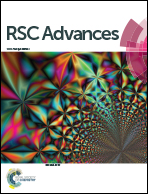Hirundigenin type C21 steroidal glycosides from Cynanchum stauntonii and their anti-inflammatory activity†
Abstract
Six new hirundigenin-type C21 steroidal glycosides, namely hirundigosides E–J (1–6), were obtained from the dried roots of Cynanchum stauntonii. Their chemical structures were elucidated by analyses of HR ESI-TOF MS, 1D, 2D-NMR, and X-ray crystallographic methods together with acidic hydrolysis. Interestingly, they exist in nature as epimers owing to the presence of 14-hemiketal hydroxyl group. Moreover, it is striking that only one set of resonance signals (14β-OH epimer) appeared in the 1H and 13C NMR spectra of compounds 1–6 when measured in CDCl3, while two sets of resonance signals (14α- and 14β-OH epimers) were observed when measured in pyridine-d5. It may ascribe to the favorable formation of intramolecular hydrogen bond of aglycone due to the proximate distance of hydroxyl group and oxygen atoms (1.86 nm) in 14β-OH epimer in CHCl3. The difference of potential energy (ΔG) of 14α-OH epimer to 14β-OH epimer is about 0.73 kcal mol−1 for compound 1 in CHCl3, while it is unfavorable for the formation of intramolecular hydrogen bond in pyridine and the G values of them are almost equal in 1. Also, CDCl3 is neither protic solvent nor Lewis acid and it can't induce the isomerization of hemiketal hydroxyl group in hirundigosides, while pyridine is Lewis base and it promotes the isomerization of hirundigosides. In addition, secondary anhydrohirundigenin-type glycosides and anhydrohirundigenin were obtained by mild acidic hydrolysis and their anti-inflammatory activities were also discussed.



 Please wait while we load your content...
Please wait while we load your content...